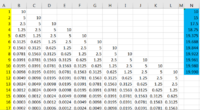Just FYI - half life is not a reliable means of avoiding detection times. A lot of tests look for metabolites which can remain in your system loooong after the parent compound has been metabized.
The math is essentially correct - if dosing 1x per half life (1x every 6 hours for a compound that has a 6 hr half life or in this case 1x every 24 hours with a 24 hour half life) will yield peak levels that eventually equal twice the dose, assuming instant and complete absorption.
The key here is that you get to a point where the amount you burn in between doses is equal to the dose you are taking. Or in this case, you have to have 2x the dose to burn through half of it in between doses - if that makes sense.
If you are dosing at a rate other than 1x half life (like 3x per half life or 0.66x per half life) the math gets more interesting.
For instance, there is a drug that can't be mentioned on this site that is rumored to have a half life of 36 hours, with 1x per day dosing usually. It is typical to have steady state levels of approx. 3x the dose in that scenario.
And the pharmacodynamics can slightly change things as well. If something absorbs over time, you may start metabolising a certain amount of it and then digest more, increasing the amount in the system which also increases the burn rate. But this gets more complex than I think you really need for most compounds.
So, short answer - your math is accurate and you seem to get it.

